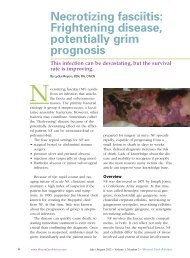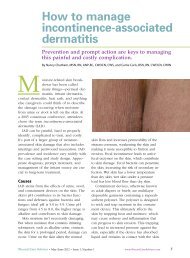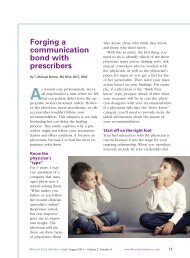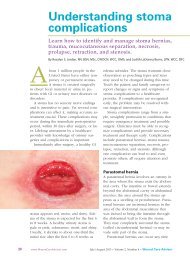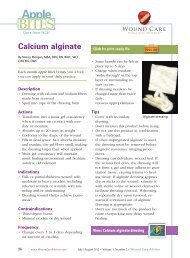FAQs for pressure ulcer staging - Wound Care Advisor
FAQs for pressure ulcer staging - Wound Care Advisor
FAQs for pressure ulcer staging - Wound Care Advisor
Create successful ePaper yourself
Turn your PDF publications into a flip-book with our unique Google optimized e-Paper software.
<strong>FAQs</strong> <strong>for</strong> <strong>pressure</strong><strong>ulcer</strong> <strong>staging</strong>By Donna Sardina, RN, MHA, WCC, CWCMS,DWC, OMSStaging <strong>pressure</strong> <strong>ulcer</strong>s can be challenging.Below are some commonquestions—and answers—about<strong>staging</strong>.QIf a <strong>pressure</strong> <strong>ulcer</strong> heals (completelyepithelialized over), but later reopensat the same site, how should it be staged?AAccording to the National PressureUlcer <strong>Advisor</strong>y Panel, if a <strong>pressure</strong><strong>ulcer</strong> reopens in the same site, the <strong>ulcer</strong>should be listed at the previous <strong>staging</strong>diagnosis (<strong>for</strong> example, if it was a Stage IVbe<strong>for</strong>e it closed, it would be a Stage IVwhen it reopened). 1Remember that <strong>pressure</strong> <strong>ulcer</strong>s heal to aprogressively more shallow depth. Theydon’t replace lost muscle, subcutaneous fat,or dermis be<strong>for</strong>e they reepithelialize. Instead,the full-thickness <strong>ulcer</strong> is filled withscar tissue composed primarily of endothelialcells, fibroblasts, collagen, and extracellularmatrix. A Stage IV <strong>pressure</strong> <strong>ulcer</strong>,there<strong>for</strong>e, can’t become a Stage III, StageII, or subsequently Stage I <strong>pressure</strong> <strong>ulcer</strong>. 1QCan <strong>pressure</strong> <strong>ulcer</strong> <strong>staging</strong> be used<strong>for</strong> venous <strong>ulcer</strong>s?ANo. The National Pressure Ulcer <strong>Advisor</strong>yPanel and European PressureUlcer <strong>Advisor</strong>y Panel state that a <strong>pressure</strong><strong>ulcer</strong> classification system can’t be used todescribe tissue loss in wounds other than<strong>pressure</strong> <strong>ulcer</strong>s. 2QIfa wound first presents as a suspecteddeep-tissue injury (SDTI) and thenbecomes open, should I chart it as a healingSDTI or restage it as it presents?AStaging is based on the deepest levelof tissue destruction through the layersof skin; there<strong>for</strong>e, you stage accordingto what level of destruction you seeand/or feel. So, as the <strong>ulcer</strong> changes characteristics,you should restage it basedupon what you see.Remember to refer back to the definitions<strong>for</strong> each stage, and if you can’t tellwhat you are looking at, document thewound as unstageable.QOnce a <strong>pressure</strong> <strong>ulcer</strong> is debrided,does it become a surgical wound andno longer need <strong>staging</strong>?AAccording to the Centers <strong>for</strong>Medicare & Medicaid Services (CMS),a <strong>pressure</strong> <strong>ulcer</strong> that has been surgicallydebrided remains a <strong>pressure</strong> <strong>ulcer</strong>, andisn’t considered a surgical wound. 3,4QWhat would be the new stage <strong>for</strong> aStage II <strong>pressure</strong> <strong>ulcer</strong> that developsslough?ABecause <strong>staging</strong> is based on thedeepest level of tissue destructionthrough the layers of skin, you wouldstage the <strong>ulcer</strong> according to the level ofdestruction you see and/or feel.If the Stage II <strong>ulcer</strong> is covered in sloughto the extent you can’t see or palpate thedeepest level of tissue destruction, itwould be considered unstageable. However,if there is scattered, superficial sloughand the deepest level of tissue destructioncan be seen or palpated, then the <strong>ulcer</strong>would be either a Stage III or Stage IV.QIf a Stage IV <strong>pressure</strong> <strong>ulcer</strong> is repairedwith a surgical flap, would it still be aStage IV or would it be unstageable?14 www.<strong>Wound</strong><strong>Care</strong><strong>Advisor</strong>.com November/December 2012 • Volume 1, Number 4 • <strong>Wound</strong> <strong>Care</strong> <strong>Advisor</strong>
Stages of <strong>pressure</strong> <strong>ulcer</strong>sSuspected deep tissue injuryStage 1Stage 2Stage 3Stage 4UnstageableAAccording to the CMS, if a muscleflap, skin advancement flap, or rotationalflap is per<strong>for</strong>med to surgically replacea <strong>pressure</strong> <strong>ulcer</strong>, the area is considereda surgical wound and is no longer a<strong>pressure</strong> <strong>ulcer</strong>. If the flap fails, continueto code the area as a surgical wound untilit’s healed. 3,4QCan a wound have two stages? My patienthas a Stage III <strong>pressure</strong> <strong>ulcer</strong>, butI also see dark purple around part of it.Should I document it as Stage III with suspecteddeep-tissue injury?AA wound can’t have two stages. Theentire <strong>pressure</strong> <strong>ulcer</strong> should bestaged based upon the deepest level of tissuedestruction in the <strong>ulcer</strong>, so in this casethe wound would be considered Stage III.A Stage III depth is deeper than a suspecteddeep-tissue injury.QI know that friction and shearing contributeto <strong>pressure</strong> <strong>ulcer</strong> developmentbut when do I stage it? For example, a patient’selbow has rubbed across the surface ofthe bed, resulting in missing epidermis. Is thisnow an abrasion or a Stage II <strong>pressure</strong> <strong>ulcer</strong>?AThe situation you describe would bean abrasion.It’s worthwhile to consider the role offriction and <strong>pressure</strong> <strong>ulcer</strong>s. Friction <strong>for</strong>ceoccurs when two objects rub against eachother. Friction isn’t a direct cause of <strong>pressure</strong><strong>ulcer</strong>s, but can contribute to shearstresses in skin and in deeper tissue layers,which, in combination with <strong>pressure</strong>, resultsin <strong>pressure</strong> <strong>ulcer</strong>s. 5<strong>Wound</strong> <strong>Care</strong> <strong>Advisor</strong> • November/December 2012 • Volume 1, Number 4 www.<strong>Wound</strong><strong>Care</strong><strong>Advisor</strong>.com 15
QCan a patient have a friction woundwithout <strong>pressure</strong>?AFriction <strong>for</strong>ce occurs when two objectsrub against each other. According toHanson and colleagues, “Friction abradesthe skin of the epidermis and dermis, therebydecreasing the amount of <strong>pressure</strong> neededto create a <strong>pressure</strong> <strong>ulcer</strong>.” 6QCan a patient have a shearing woundwithout <strong>pressure</strong>?AYes, but it’s rare. Pressure on soft tissues,especially when over a bonyprominence, will cause some degree ofshear through tissue distortion. 2,5 Shearstresses arise from <strong>for</strong>ces applied tangentiallyto a surface and cause de<strong>for</strong>mationof the object involved. Shear stresses usuallyoccur in combination with <strong>pressure</strong>. 5QA patient’s waistband dug into hisside and caused skin breakdown. Isthis considered a <strong>pressure</strong> <strong>ulcer</strong>?AYes. Pressure along with friction fromthe constriction of the waistband ismost likely the cause of the skin breakdown,and this would be considered a<strong>pressure</strong> <strong>ulcer</strong>.QA patient has a cast or device removedand there is skin breakdownunderneath. Is this a <strong>pressure</strong> <strong>ulcer</strong>?AYes, this would be considered a <strong>pressure</strong><strong>ulcer</strong> and would need to bestaged according to depth of the tissuedestruction.QMy patient has a <strong>pressure</strong> <strong>ulcer</strong> that is100% filled with slough, and I’ve determinedit’s unstageable. In addition todocumenting length and width, should Ialso try to determine a depth? Can youtechnically have a depth that is 0.1 cm?AIt can be difficult to measure depth insuperficial partial-thickness <strong>ulcer</strong>s orwounds covered with slough. If the depthis less than 1 mm, document as “< 0.1 cm.” 7Keep in mind that if a wound is open,it will have depth, because at least theepidermis has been penetrated. The epidermishas a thickness of 0.1 to 0.6 mm,and the dermis thickness can range from 2to 4 mm.■Resources• National Pressure Ulcer <strong>Advisor</strong>y Panel.NPUAP <strong>pressure</strong> <strong>ulcer</strong> stages/categories.• Pressure <strong>ulcer</strong> <strong>staging</strong> test. Practice yourskills.References1. National Pressure Ulcer <strong>Advisor</strong>y Panel. The factsabout reverse <strong>staging</strong> in 2000. The NPUAP PositionStatement. http://www.npuap.org/wp-content/uploads/2012/01/Reverse-Staging-Position-Statement%E2%80%A8.pdf. Accessed November 1, 2012.2. National Pressure Ulcer <strong>Advisor</strong>y Panel and EuropeanPressure Ulcer <strong>Advisor</strong>y Panel. Prevention andtreatment of <strong>pressure</strong> <strong>ulcer</strong>s: clinical practice guideline.Washington, DC: National Pressure Ulcer <strong>Advisor</strong>yPanel; 2009.3. Centers <strong>for</strong> Medicare & Medicaid Services. OASIS-CGuidance Manual September 2009 <strong>for</strong> 2010 ImplementationChapter 3: F-1. vnaa.org/vnaa/g/?H=HTML/doc/OASIS-C_ItemGuidance.pdf. Accessed November1, 2012.4. Centers <strong>for</strong> Medicare & Medicaid Services. RAIVersion 3.0 Manual. Section M. October 2011.5. International Review. Pressure <strong>ulcer</strong> prevention:<strong>pressure</strong>, shear, friction and microclimate in context.A consensus document. London: <strong>Wound</strong>s International;2010.6. Hanson D, Langemo DK, Anderson J, ThompsonP, Hunter S. Friction and shear considerations in<strong>pressure</strong> <strong>ulcer</strong> development. Adv Skin <strong>Wound</strong> <strong>Care</strong>.2010 Jan;23(1):21-4.7. Hess CT. Clinical Guide to Skin and <strong>Wound</strong> <strong>Care</strong>.7th ed. Philadelphia, PA: Lippincott Williams &Wilkins; 2012;chap 2.Donna Sardina is Editor-in-Chief of <strong>Wound</strong> <strong>Care</strong><strong>Advisor</strong> and cofounder of the <strong>Wound</strong> <strong>Care</strong> EducationInstitute in Plainfield, Illinois.16 www.<strong>Wound</strong><strong>Care</strong><strong>Advisor</strong>.com November/December 2012 • Volume 1, Number 4 • <strong>Wound</strong> <strong>Care</strong> <strong>Advisor</strong>



